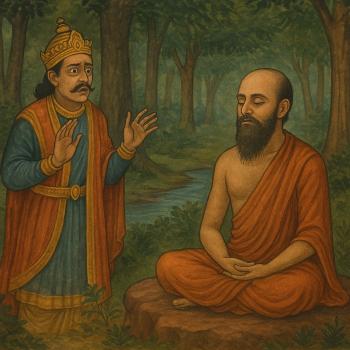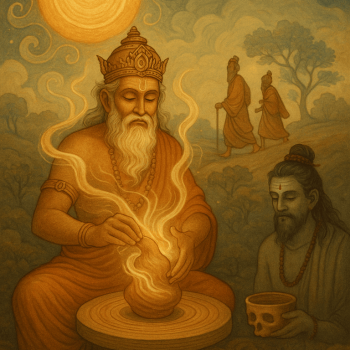
It was a quiet night. My son was finally asleep beside me, but I wasn’t. I sat on the edge of the bed, holding my knees to my chest, tears silently running down my face. The walls around me were unfamiliar. The city was unfamiliar. I had just escaped a painful marriage, carrying nothing but two suitcases, a few savings, and my 10-month-old son. I had no family here, no friends, and no plan. Just a deep, aching question: “Will I ever feel whole again?”
I didn’t feel strong. I felt broken. But somewhere deep within, there was a spark—a whisper of courage. That whisper came alive when I turned to a book I had read many times before, but never truly understood until now: the Bhagavad Gita.
The Scripture That Spoke to My Soul
In those moments of darkness, therapy felt clinical. Self-help books gave me checklists but no peace. Friends offered support, but not understanding. I was aching not just for solutions, but for wisdom. That’s when I picked up the Gita—not as a religious act, but as a desperate reach for truth.
I randomly opened a page and read:
“From attachment arises desire; from desire, anger; from anger, delusion; from delusion, confusion of memory; from confusion of memory, loss of reason; and from loss of reason, one falls into ruin.” (Gita 2.62–63)
I paused.
I re-read it. Then, I read it again. It was like a mirror. I had become so deeply attached to the idea of a perfect relationship, a happy family, and an ideal future that I lost clarity, ignored red flags, silenced my instincts, and sacrificed my dignity. I had confused love with attachment, patience with suppression, and duty with self-destruction.
That verse didn’t shame me. It freed me. It told me that my suffering wasn’t my weakness—it was my wake-up call.
Detachment Is Not Coldness—It’s Clarity
One of the Gita’s central teachings is detachment. At first, I misunderstood this word. I thought it meant emotional numbness or indifference. But as I read more, I realized: detachment is not about withdrawing from life—it’s about engaging with life without clinging, craving, or fearing outcomes.
The Gita was not asking me to stop loving or caring. It was teaching me to let go of toxic emotional dependence. I could still love my child, do my duties, and build new relationships—but I had to stop seeking validation, control, or salvation from others.
That shift was transformative. I began to see my past not as a source of guilt, but as a classroom. I was not a victim—I was a student of life, and Krishna was my teacher.
The Power of Sthitaprajna: Becoming Emotionally Balanced
The concept of Sthitaprajna—a person of steady wisdom—became my inner goal. The Gita describes this state as someone who remains composed in pleasure and pain, gain and loss, praise and criticism.
I started practicing this emotionally. When triggers came—an old photo, a judgmental comment, a moment of loneliness—I paused. I observed. I responded with awareness instead of reacting with fear. I journaled my thoughts, meditated every morning, and spoke affirmations out loud.
This wasn’t spiritual bypassing. I still cried. I still felt anger. But I no longer let those emotions define or derail me. I was learning to ride the waves instead of drowning in them.
Dharma: Finding My Purpose in Pain
Another powerful teaching that shaped my healing was the idea of Dharma—my personal path, responsibility, and truth.
“Better is one’s own dharma, though imperfect, than the dharma of another well performed.” (Gita 3.35)
I realized I didn’t have to live someone else’s idea of a good life. I didn’t have to pretend to be the perfect wife or perfect woman. My dharma, at that time, was simple and profound: to raise my son in peace, to rebuild my self-worth, and to share my story so others would feel less alone.
That clarity gave me strength. I stopped comparing myself to others. I focused on what truly mattered. I began writing. Speaking. Teaching. The wound became the wisdom. The breakdown became the breakthrough.
A New Beginning in a New Land
Starting over in a new country with a baby wasn’t easy. I was scared. But the Gita gave me a mindset that turned fear into fuel.
Each morning, I asked myself:
- What is my duty today?
- Can I act without fear or expectation?
- Can I be kind to myself in this moment?
Slowly, opportunities came. I found a job. I built a community. I created a home filled with laughter and light. My son became my little companion on this journey of healing. Together, we created a new rhythm of life.
And I dressed up every day—not for the world, but as an act of self-respect. Every time I wore something beautiful, I reminded myself: “I am not broken. I am becoming.”
Gita Psychology: From Personal Pain to Public Purpose
Inspired by my journey, I started developing what I now call Gita Psychology—a practical model that combines the spiritual insights of the Gita with modern emotional healing.
I coach women who feel lost after trauma, guide them through reflection practices based on Krishna’s teachings, and help them rebuild their lives not just externally, but from the inside out.
This work isn’t about preaching. It’s about walking with others through darkness, as someone who has walked that path herself.
For Anyone Reading This in Pain
If you’re going through heartbreak, separation, or deep emotional pain, I want to offer this truth:
You are not alone.
You are not weak.
You are not broken.
You are evolving.
The Bhagavad Gita is not just an ancient book—it’s a guide for the modern soul. You don’t need to be religious to read it. You just need to be willing to listen. Start with one verse. One truth. One breath. Let it hold your hand.
“The soul is neither born, nor does it ever die… It is unborn, eternal, ever-existing, and primeval.” (Gita 2.20)
You are that soul. Divine. Whole. Timeless.
Final Words
Healing is not a destination—it’s a journey. One that requires courage, compassion, and clarity. The Bhagavad Gita gave me all three. It reminded me that the worst day of my life was also the beginning of my best self.
And today, I stand not as a victim, but as a voice.













